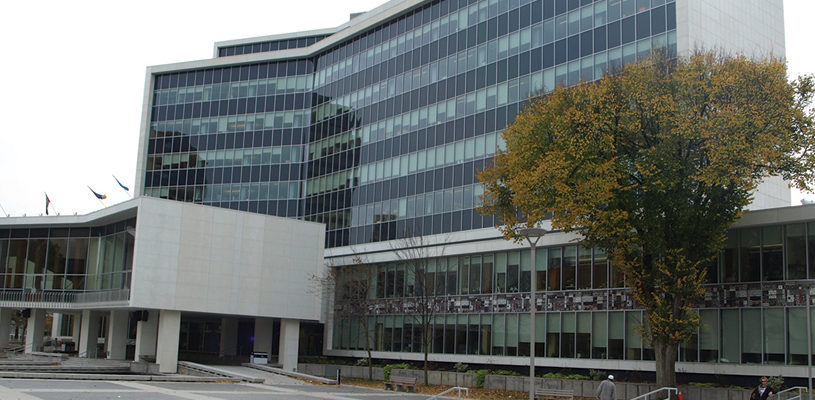Mad about modernism

When you think about heritage buildings, you often picture cute Victorian houses and main streets or grand Gothic Revival churches. Buildings from the 1950s and 1960s do not often fit into this preconceived notion. People may believe they are too new to be considered “heritage” or that they are ugly. Though “beauty” is not a value we use in Canada to identify buildings of historic, architectural, or contextual significance, it does play a role in public opinion surrounding the preservation of such structures. It is public apathy that perhaps represents the greatest risk to these buildings. However, a new movement is now surfacing in Canada, urging municipalities to recognize and preserve their Modernist architecture.
What are Modernist Buildings?
The Modernist movement in architecture in Canada can be traced back to 1940. The movement lasted into the 1970s, after which we enter the Postmodern era. These buildings did not feature the ornate decoration as was often typical of earlier buildings; instead, they showcased abstract art in the form of mosaics, murals, or furniture. The buildings were designed to focus on function, and the exterior had clean lines with a horizontal or vertical emphasis. Modernist buildings can be recognized by their futuristic look (or by an appearance that suggests thinking that Don Draper – of television’s Mad Men fame – might have lived or worked there).
The Meccas of Modernist architecture are Canada’s larger cities: Vancouver, Ottawa, Calgary, Toronto, Winnipeg, and, interestingly, Peterborough – where most of Trent University is constructed in this style. But, the style is also found in smaller cities and towns across the country.
Modernist structures come with their own conservation challenges, specifically the maintenance of their building material, which was often new or experimental. However, like other heritage buildings, their preservation may be seen as an obstacle in areas scheduled for growth. Adaptive reuse and finding an architect with knowledge of the construction methods is also a challenge that both traditional heritage buildings and Modernist era buildings share – as is developing an understanding and appreciation of their contributions to the architectural and social history of a municipality.
Protecting Modernist Buildings in Canada
Organizations have been created to educate people about Modernist buildings and overcome public apathy. One of the most notable is the International Committee for the Documentation and Conservation of Buildings Sites and Neighbourhoods of the Modern Movement (called DOCOMOMO) and Canada has several chapters: Ontario, Quebec, Atlantic Canada, and British Columbia.
Even heritage organizations steeped in tradition, such as the 80-year-old Architectural Conservancy of Ontario (ACO), are recognizing the importance of Modernist architecture. The ACO now has a post-war architecture award that is described as:
given to an architect, engineer, planner, or landscape architect whose body of work is esteemed by professional peers and the general public alike, as being outstanding, enduring, and worthy of preservation for future generations. It acknowledges architecture, planning, and landscape design as lively, evolving arts, which draw inspiration from the past and look ahead to the future. There will come a time when the finest post-1945 works will be deemed of as great heritage value, as the finest pre-1945 architecture already is.
Organizations like the Toronto Society of Architects are advocating for protection of Modernist buildings through their Modern Heritage Building Initiative. Vancouver’s Heritage Foundation hosts walking tours of Modernist homes and the Heritage Foundation of Newfoundland and Labrador provides financial assistance for publications such as Newfoundland Modern: Architecture in the Smallwood Years 1949 – 1972. These organizations are promoting the legacy of Canada’s Modernist architecture.
The increasing interest in Modernism is highlighted by other initiatives, including a recent whole issue of Spacing Magazine on the subject, with a specific focus on Toronto. There are also popular Facebook groups dedicated to sharing pictures and information about modern buildings such as Mid Century Modern Calgary and Forest City Modern.
Governments Take Action
Municipalities and government agencies have been moving to protect Modernist heritage buildings through their heritage legislation. In Mississauga, Ontario, the city designated a unique Canadian Tire gas bar canopy. Its futuristic swoop design was considered a landmark in the community.
In Alberta, the province is moving to designate the Barron Building. This 1951 skyscraper is a good example of the International style, with a central tower and two wings. Located in downtown Calgary, the building served as offices for many oil companies, such as Shell and TransCanada Pipelines.
Although there have been several one-off designations of Modernist buildings, entire neighbourhoods have also been recognized. In the City of Ottawa, Briarcliffe was designated as a Heritage Conservation District in 2013. The district is a community with 23 houses built between 1961 and 1969. The houses are each unique and they are set among a forest landscape.
The urgency for protection of these buildings is being spurred by their rapid destruction. Year after year, Modernist buildings make it on to the Top 10 Endangered Buildings list published by Heritage Canada The National Trust. In 2013, it was Vancouver’s Main Post Office, built in 1953-1959 – the city’s best example of the International style. In 2012, it was Hamilton’s board of education building, and in 2011, the Bank of Montreal building in Edmonton – both of which are now demolished. The Winnipeg airport terminal, which was featured on the 2008 list, was also demolished.
Case Study: City of Hamilton
The City of Hamilton (my home town) is a microcosm of the tension surrounding the recognition of Modernist structures that has been happening all over the country. The city hall is a Modernist landmark. It was designed in 1960 in the International style by Stanley Roscoe, Canada’s first municipal architect. The city recognized the importance of the building by designating it under the Ontario Heritage Act. A Canadian Tire Gas Bar canopy similar to the one in Mississauga has been considered for designation, but will likely not proceed due to public opinion.
However, Hamiltonians clearly have a passion for modernism. Just across the street from the city hall, citizens lost the battle to save the board of education building. Though the effort to save the building was initiated by citizens, there were equally vocal advocates who supported the demolition.
The HIStory and HERitage gallery in the artist district on James Street North featured an exhibit called “Sleek 2 Sleek: Modern Residential Architecture in Hamilton” that challenged people to look beyond traditional architecture to appreciate the mid-century modern residential architecture designed by Hamilton architects. It was so successful that a second exhibition, “Sleek 2”, was developed.
Conclusion
Modernist buildings represent a specific time period in Canada’s history. They speak to the optimism felt after the end of WWII and showcase the building boom in the country. Many Modernist buildings were constructed as part of cities’ urban renewal projects. Though their beauty might be questioned by some, their heritage value is clear. Many organizations are educating people about their value through walking tours, exhibitions, and awards. Municipalities and other government agencies, who have the power to protect these buildings, are using their heritage legislation to recognize these key aspects of community history. However, there are still significant losses and a lack of appreciation for Modernist architecture. As we learn more, the movement to promote the preservation of Modernist buildings in Canada will continue to evolve. MW
KAYLA JONAS GALVIN is the Heritage Operations Manager at Archaeological Research Associates Ltd., a heritage and archaeology consulting firm based in Kitchener, Ontario. She is currently pursuing her Master’s degree in Urban Planning. You can reach her at: .
as published in Municipal World, September 2014


